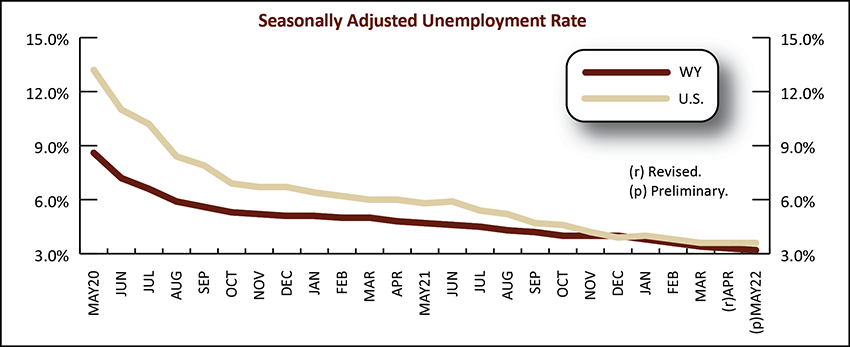Wyoming Labor Force Trends
July 2022 | Volume 59, No. 7
Click Here for PDF
Return to Table of Contents
News Release: Wyoming Unemployment Falls to 3.2% in May 2022
by: David Bullard, Senior Economist
The Research & Planning section of the Wyoming Department of Workforce Services reported that the state’s seasonally adjusted1 unemployment rate decreased slightly from 3.3% in April to 3.2% in May. Wyoming’s unemployment rate is lower than the current U.S. rate of 3.6%. From April to May, seasonally adjusted employment of Wyoming residents rose by 523 individuals (0.2%) as people returned to work.
From April to May, unemployment rates followed their normal seasonal pattern and decreased in most counties. In May, warmer weather typically brings seasonal job gains in construction, professional & business services, leisure & hospitality, and government. The largest decreases in unemployment were seen in Teton (down from 4.3% to 3.3%), Sublette (down from 4.4% to 3.5%), Big Horn (down from 3.9% to 3.2%), and Park (down from 3.5% to 2.9%) counties.
From May 2021 to May 2022, unemployment rates fell in every county. The largest decreases occurred in key energy producing counties. Natrona County’s unemployment rate fell from 6.2% to 3.8%, Sweetwater County’s rate fell from 6.0% to 3.7%, Sublette County’s rate fell from 5.8% to 3.5%, Converse County’s rate fell from 5.1% to 2.8%, and Campbell County’s rate fell from 5.5% to 3.3%.
Niobrara County, at 1.8%, had the lowest unemployment rate in May. It was followed by Crook County at 2.2%, and Weston and Goshen counties, both at 2.3%. The highest unemployment rates were found in Natrona County at 3.8%, Sweetwater County at 3.7%, and Sublette and Washakie counties, both at 3.5%.
Total nonfarm employment in Wyoming (not seasonally adjusted and measured by place of work) rose from 278,400 in May 2021 to 283,700 in May 2022, an increase of 5,300 jobs (1.9%). Employment was unusually low in 2021 because of economic disruptions related to the pandemic.
R&P's most recent monthly news release is available at https://doe.state.wy.us/LMI/news.htm.




.svg)
 Wyoming at Work
Wyoming at Work